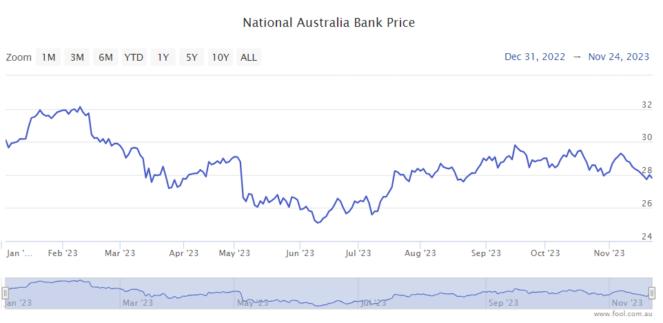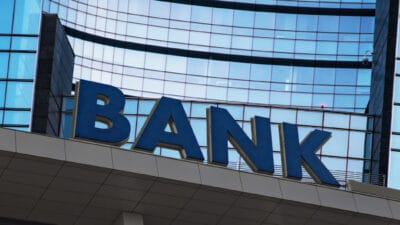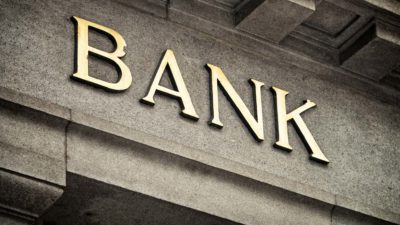National Australia Bank Ltd (ASX: NAB) shares have seen plenty of ups and downs this year. That's unsurprising considering all of the interest rate rises over the last year and a half. Since February 2023, the NAB share price is down more than 10%, which we can see on the chart below.

There's a lot of competition in the lending (and mortgage broker) space, with names like Commonwealth Bank of Australia (ASX: CBA), ANZ Group Holdings Ltd (ASX: ANZ), Westpac Banking Corp (ASX: WBC), Bank of Queensland Ltd (ASX: BOQ, Bendigo and Adelaide Bank Ltd (ASX: BEN), Macquarie Group Ltd (ASX: MQG), Suncorp Group Ltd (ASX: SUN), MyState Limited (ASX: MYS) and Australian Finance Group Ltd (ASX: AFG).
I'm sure the management of all of those businesses would like to see lending growth and profit growth, but it could be difficult for them all to achieve growth. How is NAB's outlook shaping up?
Outlook in the ASX bank share's own words
The last thing that the ASX bank share told us about was the FY23 result, which included cash earnings rising by 8.8% to $7.7 billion and the annual dividend increasing by 10.6% to $1.67 per share.
In terms of the net interest margin (NIM), in FY23 it increased by 9 basis points (0.09%) to 1.74%. Excluding a 5 basis point (0.05%) reduction from 'markets and treasury', which includes the impact of holding higher liquid assets, NIM rose by 14 basis points.
NAB said that NIM reflected higher earnings on deposits and capital as a result of the rising interest rate environment, but this was partially offset by home lending competition, deposit mix and higher wholesale funding costs.
In terms of the arrears, the amount of loans 90+ days past due was 0.75% in FY23, up from 0.66% in FY22. I think this could be a key factor for NAB shares over FY24 and perhaps FY25. If arrears jump up, it may need to account for larger bad debts in its financials, hurting profitability.
NAB wrote:
In Australia, growth has continued to slow driven by weakness in household consumption as spending adjusts to higher interest rates and cost of living pressures. With inflation now moderating, the cash rate appears to be at or near peak levels and it seems likely that Australia will avoid a pronounced economic downturn. However, real GDP growth is forecast to slow from 2.7% over 2022 to below trend rates of less than 2% p.a. over 2023 and 2024 reflecting strong expected population growth but subdued household spending. The unemployment rate is forecast to drift up to around 4.5% by end 2024 from a low of 3.4%. The extent to which households continue to adjust to cost of living pressures and higher interest rates and the timeframe over which inflation softens remain key to the outlook including the path of monetary policy.
Opinions on NAB shares
I think NAB is one of the best banks on the ASX under the current leadership. I believe its earnings could perform better than plenty of others in the sector.
In the FY23 result, its business and private banking segment saw cash earnings rise 10.1% to $3.3 billion, while corporate and institutional banking saw a 14.9% rise in cash earnings to $1.87 billion. The personal banking segment saw cash earnings fall 9.1% to $1.4 billion. Business exposure could be helpful if that area outperforms lending to households.
Broker UBS is less optimistic, with a sell rating and a price target of $26, implying a fall of 7% over the next year.
The broker thinks NAB has seen "peak earnings" and could experience "lower than system lending growth, most notably in mortgages". The broker also warned that there is rising competition in business banking, more exposure to the business credit cycle, and costs may rise due to inflation.
According to UBS, NAB is forecast to generate $1.99 of earnings per share (EPS), which would be a double-digit decline in percentage terms from FY23. It would put the current NAB share price at 14 times FY24's estimated earnings.








